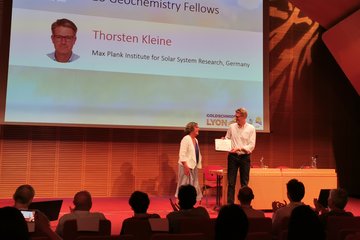Alle Typen
221.
Zeitschriftenartikel
Magnetic and electric properties of the Hubbard model for the f.c.c. Lattice. Physical Review B 17, S. 2221 - 2232 (1978)
222.
Zeitschriftenartikel
One-Dimensional Hubbard Model With Nearest and Second Nearest Neighbour Hopping in the Hartree-Fock Approximation. J. Phys. F: Metal Phys. 7, S. 401 - 406 (1977)
223.
Zeitschriftenartikel
A Survey on Initial Results of the Helios Plasma Experiment. J. Geophys. 42, S. 561 - 580 (1977)
224.
Zeitschriftenartikel
Electrical and thermal conductivity of the neutral Hubbard model. Z. Physik B 25, S. 83 - 90 (1976)
225.
Zeitschriftenartikel
Force-force correlation function method for the ideal resistance of the Hubbard model. J. Phys. C: Solid State Phys. 9, S. L117 - L120 (1976)
226.
Zeitschriftenartikel
Electrical conductivity of a doubly-degenerate Hubbard model. Physics Letters 59A, S. 293 - 294 (1976)
227.
Zeitschriftenartikel
Thermodynamics of a two-point doubly degenerate Hubbard model in the half-filled case. Phys. Stat. Sol. (b) 78, S. K39 - K44 (1976)
228.
Zeitschriftenartikel
On the frequency-dependent conductivity and the current operator of the Hubbard model. Phys. Stat. Sol. (b) 72, S. K103 - K108 (1975)
229.
Zeitschriftenartikel
A new upper bound for the free energy of the Hubbard model based on the cluster approach. Phys. Stat. Sol. (b) 69, S. K149 - K152 (1975)
230.
Zeitschriftenartikel
Electrical conduction in narrow energy bands. Z. Naturforschung 29a, S. 1655 - 1659 (1974)
231.
Zeitschriftenartikel
Thermodynamics of a two-band Hubbard model. Phys. Stat. Sol. (b) 65, S. 403 - 410 (1974)
232.
Buch
Plasma Astrophysics and Space Physics. Kluwer Academic Publishers, Dordrecht (1999), 772 S.
233.
Buch
Physics of the Inner Heliosphere, II. Particles, Waves and Turbulence. Springer-Verlag, Berlin (1991)
234.
Buch
Physics of the Inner Heliosphere, I. Large-Scale Phenomena. Springer-Verlag, Berlin (1990)
235.
Buchkapitel
Solar Space Missions: present and future. In: Formation and Evolution of Cosmic Structures: Reviews in Modern Astronomy, Volume 21, S. 229 - 248 (Hg. Röser, S.). Wiley-VCH, Weinheim (2009)
236.
Buchkapitel
Waves and turbulence in the solar corona. In: The Sun and the Heliosphere as an Integrated System, S. 283 - 317 (Hg. Poletto, G.; Suess, S. T.). Kluwer Academic Publishers, Dordrecht, The Netherlands (2004)
237.
Buchkapitel
Solar Wind. In: The Dynamic Sun, S. 374 - 402 (Hg. Dwivedi, B.). Cambridge University Press, Cambridge (2003)
238.
Buchkapitel
Solar Wind: Kinetic Properties. In: Encyclopedia of Astronomy and Astrophysics, S. 2862 - 2866 (Hg. Murdin, P.). Institut of Physics Publishing, Nature Publishing Group (2001)
239.
Buchkapitel
Dynamical processes in interplanetary space. In: The Outer Heliosphere: Beyond the Planets, S. 41 - 66 (Hg. Scherer, K.; Fichtner, H.; Marsch, E.). Copernicus Gesellschaft e.V., Katlenburg-Lindau, Germany (2000)
240.
Buchkapitel
Sonnenphysik im Weltraum mit dem Sonnenobservatorium SOHO. In: Jahrbuch der Max-Planck-Gesellschaft 1997, S. 362. Vandenhoeck & Ruprecht, Göttingen (1997)











